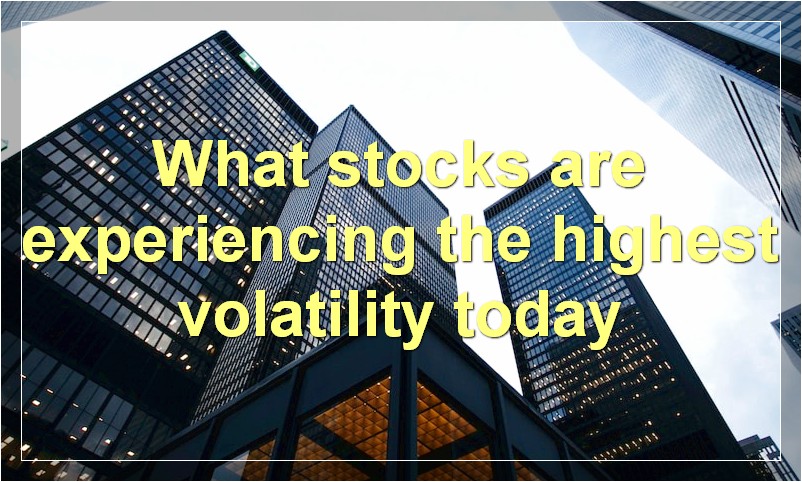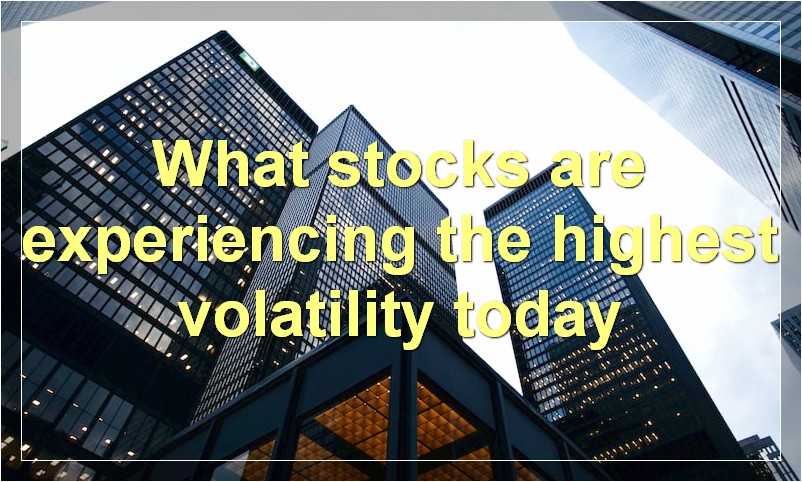The stock market is a risky investment, but there are ways to minimize your losses.
What are the most volatile stocks today
Volatility is a measure of how much the price of a security, derivative, or index moves up and down. A highly volatile stock is one that can see large swings in price over a short period of time.
There are a number of reasons why a stock might be volatile. For example, a company that is going through a lot of changes (such as a merger or acquisition) may be more volatile than others. A company that is heavily reliant on one product or service may also be more volatile if there are problems with that product or service.
There are a number of ways to measure volatility. The most common is the standard deviation, which measures how far from the average price a security has moved over a certain period of time.
The following stocks are some of the most volatile in the market today:
1. Hertz Global Holdings, Inc. (HTZ)
2. AMC Entertainment Holdings, Inc. (AMC)
3. Crocs, Inc. (CROX)
4. GameStop Corp. (GME)
5. bed Bath & Beyond Inc. (BBBY)
What stocks are experiencing the highest volatility today

There are many factors that can contribute to a stock’s volatility. Today, some of the stocks experiencing the highest volatility are in the healthcare and biotech sectors. This is likely due to the ongoing debate about the Affordable Care Act and its potential impact on these industries. Other stocks that are seeing high levels of volatility include those in the energy sector. This is likely due to the recent increase in oil prices and the uncertainty about the future of the industry.
Why are some stocks more volatile than others
There are a few factors that can contribute to why some stocks are more volatile than others. One factor could be the company’s size. Generally, smaller companies are more volatile because they have less capital and resources than larger companies. They may also be more dependent on a small number of customers or suppliers. Another factor could be the industry the company is in. Some industries are inherently more volatile than others, such as the tech industry which is often subject to big swings based on consumer confidence. Additionally, companies with a lot of debt may also be more volatile because they have more risk. Finally, stocks that are not well diversified may also be more volatile. This is because if the company has all its eggs in one basket, then it is more vulnerable to changes in that one area.
What factors influence a stock’s volatility
There are many factors that can influence a stock’s volatility, including the overall market conditions, the company’s financial stability, and global events. While some investors may view volatile stocks as riskier investments, others see it as an opportunity to make quick profits.
How does volatility impact investors
Volatility is a key concept in finance that refers to the degree of fluctuation in the price of a security. A security with high volatility experiences larger swings in price than a security with low volatility. For investors, volatility can have both positive and negative impacts.
On the positive side, volatile securities offer the potential for greater returns. This is because investors are typically compensated with higher returns for assuming more risk. Therefore, a stock that is more volatile than the market as a whole has the potential to outperform the market over time.
On the negative side, volatile securities also come with greater risks. This is because sharp swings in prices can lead to losses if an investor is not carefully monitoring their positions. In addition, volatile markets can be more difficult to predict and can generate anxiety for investors who are risk-averse.
Overall, volatility is an important consideration for all investors. Those who are willing to take on more risk may be rewarded with higher returns, but they must also be prepared for the possibility of losses.
Is there a difference between good and bad volatility

Is there a difference between good and bad volatility?
The answer may surprise you.
Volatility, in its simplest form, is the ups and downs of the stock market. But there can be good volatility and bad volatility. Good volatility is when the market is going up, and bad volatility is when the market is going down.
So, what’s the difference between the two?
Good volatility is created by good news. For example, if a company releases strong earnings, that’s good news and will likely lead to good volatility. Bad volatility is created by bad news. If a company misses earnings estimates, that’s bad news and will likely lead to bad volatility.
The key difference between good and bad volatility is the direction of the market movement. Good volatility leads to an increase in stock prices, while bad volatility leads to a decrease in stock prices.
Investors should always keep an eye on volatility because it can have a big impact on their portfolios. Volatility can be a friend or foe, depending on how it’s used.
Can volatility be predicted
There is no easy answer when it comes to predicting volatility. Many factors can influence the amount of volatility in the market, including political and economic events. While there are some methods that investors use to try and predict volatility, there is no guaranteed way to know what the market will do in the future.
That being said, there are still some strategies that can be used to help manage risk when investing in volatile markets. For example, diversification is often cited as a way to mitigate risk. By investing in a variety of assets, you can help protect yourself from the potential downside of any one investment.
Another common approach is to use stop-loss orders when buying or selling securities. This can help limit your losses if the market moves against you.
Ultimately, there is no surefire way to predict volatility. However, by being aware of the risks involved and taking steps to diversify your portfolio, you can help protect yourself from potential losses.
How do investors trade volatile stocks
1. Many investors choose to trade volatile stocks because they offer the potential for high returns. However, these stocks can also be very risky and may result in substantial losses.
2. When trading volatile stocks, it is important to have a well-defined strategy and to be prepared for both good and bad outcomes.
3. Many investors choose to diversify their portfolios by including some volatile stocks, but this is not a decision that should be made lightly.
4. If you are considering trading volatile stocks, it is important to do your research and to understand the risks involved.
What strategies are used to profit from volatile stocks
There are a few different ways that traders can profit from stocks that are highly volatile. One popular strategy is called “scalping.” This involves taking advantage of small price movements in a stock by buying and selling it rapidly. Another common strategy is called ” day trading.” This involves holding a stock for a short period of time and selling it as soon as it reaches a certain price target.
Some traders also use options contracts to bet on the direction of a stock’s price. For example, if a trader thinks a stock is going to go up in value, they might buy a “call” option. If the stock does indeed go up in value, the trader will make a profit. Similarly, if a trader thinks a stock is going to go down in value, they might buy a “put” option. If the stock does indeed go down in value, the trader will profit.
Options trading can be risky, however, so it’s important to understand the risks involved before getting started. Volatile stocks can be profitable for traders who know what they’re doing, but they can also be very risky.
Are there any benefits to investing in volatile stocks
Volatile stocks are those that tend to fluctuate rapidly in price. Many investors view volatility as a risk, but there are also some potential benefits to investing in volatile stocks. For example, volatile stocks may be more likely to offer opportunities for buying low and selling high. They may also provide greater potential for capital gains. Of course, volatile stocks also come with greater risks, so investors need to weigh the pros and cons carefully before deciding whether or not to invest in them.

